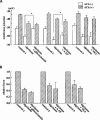Possible mechanisms underlying the vasodilatation induced by olprinone, a phosphodiesterase III inhibitor, in rabbit coronary artery
- PMID: 10696101
- PMCID: PMC1571910
- DOI: 10.1038/sj.bjp.0703125
Possible mechanisms underlying the vasodilatation induced by olprinone, a phosphodiesterase III inhibitor, in rabbit coronary artery
Abstract
The possible mechanisms underlying the vasodilatation induced by olprinone, a phosphodiesterase type III inhibitor, were investigated in smooth muscle of the rabbit coronary artery. Isometric force and membrane potential were measured simultaneously using endothelium-denuded smooth muscle strips. Acetylcholine (ACh, 3 microM) produced a contraction with a membrane depolarization (15. 2+/-1.1 mV). In a solution containing 5.9 mM K(+), olprinone (100 microM) hyperpolarized the resting membrane and (i) caused the absolute membrane potential level reached with ACh to be more negative (but did not reduce the delta membrane potential seen with ACh, 15.2+/-1.8 mV) and (ii) attenuated the ACh-induced contraction. In a solution containing 30 mM K(+), these effects were not seen with olprinone. Glibenclamide (10 microM) blocked the olprinone-induced membrane hyperpolarization. 4-AP (0.1 mM) significantly attenuated the olprinone-induced resting membrane hyperpolarization but TEA (1 mM) had no such effect. Glibenclamide (10 +microM), TEA (1 mM) and 4-AP (0.1 mM), given separately, all failed to modify the inhibitory actions of olprinone on (i) the absolute membrane potential level seen with ACh and (ii) the ACh-induced contraction. It is suggested that olprinone inhibits the ACh-induced contraction through an effect on the absolute level of membrane potential achieved with ACh in smooth muscle of the rabbit coronary artery. It is also suggested that glibenclamide-sensitive, ATP-sensitive K(+) channels do not play an important role in the olprinone-induced inhibition of the ACh-induced contraction.
Figures






References
-
- CHEN X.L., REMBOLD C.M. Nitroglycerin relaxes rat tail artery primarily by decreasing [Ca2+]i sensitivity and partially by repolarization and inhibiting Ca2+ release. Am. J. Physiol. 1996;271:H962–H968. - PubMed
-
- HONDA M., KURAMOCHI T., ISHINAGA Y., KUZUO H., TANAKA K., MORIOKA S., ENOMOTO K., TAKABATAKE T. Contrasting effects of isoproterenol and phosphodiesterase III inhibitor on intracellular calcium transients in cardiac myocytes from failing hearts. Clin. Exp. Pharmacol. Physiol. 1994;21:1001–1008. - PubMed
-
- ITOH H., KUSAGAWA M., SHIMOMURA A., SUGA T., ITO M., KONISHI T., NAKANO T. Ca2+-dependent and Ca2+-independent vasorelaxation induced by cardiotonic phosphodiesterase inhibitors. Eur. J. Pharmacol. 1993;240:57–66. - PubMed
-
- MING Z., PARENT R., LAVALÉE M. β2-adrenergic dilation of resistance coronary vessels involves KATP channels and nitric oxide in conscious dogs. Circulation. 1997;95:1568–1576. - PubMed
Publication types
MeSH terms
Substances
LinkOut - more resources
Full Text Sources

